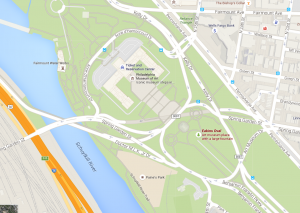Deprecated: Function get_magic_quotes_gpc() is deprecated in /hermes/bosnacweb08/bosnacweb08bf/b1577/ipg.rifuturecom/RIFutureNew/wp-includes/formatting.php on line 4387
Deprecated: Function get_magic_quotes_gpc() is deprecated in /hermes/bosnacweb08/bosnacweb08bf/b1577/ipg.rifuturecom/RIFutureNew/wp-includes/formatting.php on line 4387
Deprecated: Function get_magic_quotes_gpc() is deprecated in /hermes/bosnacweb08/bosnacweb08bf/b1577/ipg.rifuturecom/RIFutureNew/wp-includes/formatting.php on line 4387
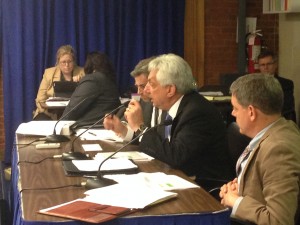
Director Peter Alviti of RIDOT recently stated his own version of reality about the 6/10 Connector when he said that, “Hypothetical plans or other scenarios could be explored in the world of theory, but in the world of reality we are facing we now need to address this structurally deficient problem.”
Alviti’s words are dismissive of basic commuting and engineering realities. It’s not really clear why spending $5-6 million to temporarily brace the Huntington Bridge would be unacceptable since it would open up time to discuss plans that may save the state hundreds of millions of dollars on the 6/10 Connector. Be that as it may, Alviti’s insistence that boulevard experts across the country are fanciful imagineers got me thinking about the most recently departed icon of imagination. As the City of Providence fights back against RIDOT, it’s going to have to take a page from the book of Willy Wonka. And no, not the Johnny Depp version, the real thing.
Every child loves Willy Wonka and the Chocolate Factory but it takes adult eyes to see one of the key lessons of the movie. My uncle pointed out to me growing up that what’s funniest to adults about the Gene Wilder representation of Wonka is that he never seems to raise his voice when the time is appropriate. This was obvious to my uncle, the father of four girls, because as a parent he understood how ineffective Wonka was being, and read that it was intentional.
Help. Police. Murder.
Kevin Proft, whose excellent pieces in Eco RI have put me to shame month after month for their fine-toothed journalistic detail on 6/10, deserves credit again for his excellent piece juxtaposing the various statements of RIDOT Director Peter Alviti has made before and after the supposed “emergency” that Gov. Raimondo announced Sept. 7th. But deep inside this sharp critique of Raimondo and Alviti is an important statement about Mayor Jorge Elorza as well:
Mayor Jorge Elorza and the city are pushing back, lightly. The mayor agreed to be at the governor’s press conference, and was commended twice by Raimondo for his support of her decision.
“I want to thank all of the mayors who have come together today in support of this. Mayor Elorza … it’s been a pleasure to work with you,” the governor said at the start of her remarks.
It’s unclear how supportive the mayor actually is. In his own remarks at the Sept. 7 press conference, he noted the importance of safe infrastructure, but said public safety doesn’t need to come at the expense of the city’s needs.
“While we know the bridge must be addressed in short order, we remain enthusiastic about the opportunity to collaborate with the state on the options to enhance and improve the 6-10 corridor as a whole,” Elorza said. “RIDOT, the city, and the community have all articulated a larger goal for this project including enhanced mobility options, improving the quality of place and quality of life in and around the corridor, and opening up new areas of economic development and jobs.
“We can invest these dollars in a way that ensures the safety of this roadway and also enhances the livability of this entire corridor. It’s our responsibility to advocate for the smartest investment of these dollars.”
Mayor Elorza can’t ride this fence for long. Though everyone agrees that he supports the boulevard, what counts is not just the words that are said, but the tone and manner in which they’re said.
Eventually Wonka finds his voice.
“It’s all there, black and white. Clear as crystal. You STOLE Fizzie Lifting Drinks. You bumped into the ceiling which now has to be washed and sterilized, and so you get NOTHING. YOU LOSE. GOOD DAY, SIR.”
We’re at a delicate place, and theatrics matters. Governor Raimondo doesn’t have the facts behind her, and nor does Director Alviti. There is no reason why stabilizing the Huntington Bridge entails curtailing the rights of Providence residents to participate fully in the public process and see their vision built. But facts don’t matter. Theater does. The mayor needs to learn from the late Gene Wilder and put a bit more magic in his step.
Mayor Elorza has been taking on a lot of issues. He’s fighting hard on Liquified Natural Gas, and just unveiled an ambitious plan to fight the root causes of poverty and homelessness near Kennedy Plaza. These deserve praise.
But it’s time to do the same on 6/10. If not, we’ll be stuck with this design for 75-100 years, and no one reading this will be able to affect change in their lifetimes.
Mayor Elorza has been taking on a lot of issues. He’s fighting hard on Liquified Natural Gas, and just unveiled an ambitious plan to fight the root causes of poverty and homelessness near Kennedy Plaza. These deserve praise.
But it’s time to do the same on 6/10. If not, we’ll be stuck with this design for 75-100 years, and no one reading this will be able to affect change in their lifetimes.
To quote Wonka: “We are the music makers, and we are the dreamers of dreams.” It might seem silly, but dreams have greater power to motivate people to action than facts. It’s time to make a stronger statement. Show some imagination! Call a press conference at the 6/10 Connector. But speak up.
]]>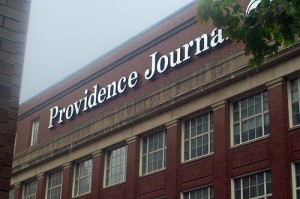 The Providence Journal editorial board posted a piece praising Governor Gina Raimondo for her decision to ignore the public process and the recommendations of national and local experts to fast-track the reconstruction of the 6/10 Connector.
The Providence Journal editorial board posted a piece praising Governor Gina Raimondo for her decision to ignore the public process and the recommendations of national and local experts to fast-track the reconstruction of the 6/10 Connector.
The Projo is, as a journalistic entity, free to make whatever statements it wants on any issue. The problem with the Projo’s editorial is that it is wrong on basic facts that all parties agree to. Quoth the Projo:
Gov. Gina Raimondo, thus, did the right thing by responding boldly to new evidence that bridges along that stretch are in perilous condition, putting the public’s safety at risk. She announced Wednesday that the state must repair these crumbling structures as quickly as possible.
In doing so, she had to pull the plug on an extravagant $595-million state Department of Transportation plan to cap the highway and knit back together neighborhoods that have been disconnected for decades with a new surface boulevard. That plan would have taken longer and cost more than simply fixing the bridges.
Three plans have been considered during the 6/10 Connector public process: rebuilding the highway as-is, rebuilding the highway with a cap over it at certain crossings, and a surface boulevard. The “rebuild with a cap” option, though better described as a highway plan, has been labeled by the Rhode Island Department of Transportation (RIDOT) as a “highway-boulevard hybrid.” Hence the confusion.
Everyone agrees that the surface boulevard would be the cheapest option of the three. That option, as outlined by community group Fix the 6/10, would cut down the amount of infrastructure spending needed to complete the project, while restoring the grid to drivers:
Rebuilding a highway in the 6/10 corridor, especially if it involves a cap, will cost at least $600 million, hundreds of millions more than a surface alternative. A surface option will cost taxpayers much less, making resources available for other projects throughout the state. Further, the ongoing maintenance costs of the highway option will burden our children with billions of dollars of maintenance and replacement costs. A surface road option will also unlock dozens of taxable acres for development, improving the region’s fiscal health.
In a Cranston public forum on the 6/10 Connector, Eco RI news documented that RIDOT officials intentionally spun the capped highway option as best, holding information that would favor the surface boulevard close to their chest unless specifically grilled on it:
RIDOT officials routinely downplayed instances where the boulevard option compared favorably to the capped-highway idea. At the meeting in Olneyville, it wasn’t until ecoRI News asked about the relative costs of the options — more than an hour into the meeting — that RIDOT revealed the boulevard option would cost taxpayers less. The difference remains undetermined, as RIDOT hasn’t calculated the cost of the boulevard option.
If the Projo had made such an error in a news article, it would be a problem. But for an editorial whose thesis is that the governor is making the tough decisions needed to save money, mistaking two of the three options on the table for one another, and then getting the costs of the options wrong calls for a full retraction.
~~~~
]]>Deprecated: Function get_magic_quotes_gpc() is deprecated in /hermes/bosnacweb08/bosnacweb08bf/b1577/ipg.rifuturecom/RIFutureNew/wp-includes/formatting.php on line 4387
Deprecated: Function get_magic_quotes_gpc() is deprecated in /hermes/bosnacweb08/bosnacweb08bf/b1577/ipg.rifuturecom/RIFutureNew/wp-includes/formatting.php on line 4387
I’ve had two interactions with Rhode Island Center for Freedom and Prosperity CEO Mike Stenhouse, and in each I’ve found common ground with him on the issue of the 6/10 Connector. One sticking point that remains for Mike and some of his followers is the idea of bus lanes. Bus lanes have a poor reputation in conservative circles because they really haven’t been explained well.
Bus Lanes as Competition

People on the left like me often do a poor job of explaining bus lanes to conservatives. We sometimes say things like “give the bus an advantage over cars, and it can do better.” There’s some truth to that phrasing, but in a lot of ways describing bus lanes that way doesn’t really tell people what’s going on. Bus lanes are actually about allowing competition.
The sport most aligned with transportation is running. In a race, runners don’t run in queue. They have separate tracks. Jesse Owens or Jackie Joyner Kersee might not have won the races they’d won if they’d had to wait their turn in a line of other runners. The same thing is happening with a bus lane. Bus lanes can outperform cars in carrying large numbers of people. A bus is capable of carrying as many as 80 people in the space of two cars. That’s a 40-to-1 space advantage. Making a bus sit behind a car in traffic is like making all the runners wait their turn in a race. It equalizes everyone in such a way as to undermine individual strengths. That’s not conservative.
Bus Lanes as Labor-Saver
Bus lanes are labor saving. A bus driver is paid well for good reason, but we pay him or her per hour, not per mile. If a bus driver sits in traffic, we pay him or her for time wasted, instead of time used productively. This is another reason conservatives should support bus lanes.
Buses Don’t Belong Everywhere
Conservatives would be right to question whether it makes sense to put bus lanes everywhere. Bus lanes don’t belong everywhere. They need to be targeted to areas where the investment is equal or lesser to the return. A big problem with RIPTA is that it is overstretched geographically. For example, the 54 bus goes between Woonsocket and Providence—two areas very appropriate for transit—but takes twice as long to get between them as a car. That’s because suburban lawmakers have whittled out a stop here and a stop there, a bit at a time, to make sure that the bus stops where they feel it should stop. One of those stops, the Lincoln Mall, requires the bus to get off the route, go a mile out of its way in traffic, and then serve the door directly through the parking lot. The meandering trip adds several minutes in each direction, and is only one of several detours the bus is required to take. So it’s quite clear that buses are often not used to their full advantage.
The Woonsocket bus is already well-used, but could be even more well-used without these unnecessary stops. A quicker route is not only better for end-to-end times, but also allows the bus to be turned around more quickly, which increases a really important dimension of service—frequency. If the bus between Woonsocket and Providence took about the same amount of time as a car trip, but required no gas, parking, or insurance; and if it came every 15-20 minutes instead of every 30, you can start to imagine a ballooning ridership for the 54.
The most obvious problem with cutting stops is how it might affect people who are dependent on those stops. But providing better pedestrian or bike connections off of the main bus lines can do a better job for less money at standing up for the needs of these riders, while also guarding against misuse of transit funds.
Making Buses Work Without More Money
Investment in transit makes sense sometimes, but a lot of things can be improved about transit just by reordering the system. Houston, Texas has a great example, which reinforces some of the points I made about the 54 bus.
Bus Lanes Can Be Done the Expensive Way, or the Cheap Way
One mistaken assumption I’ve heard people make is to believe that bus lanes inherently cost $400 million. On the contrary, $400 million is potentially available to Rhode Island from the federal government for bus lanes. Whatever funding is available, we should still look to do bus lanes in the most efficient way, not the way government sometimes does things, which is to try to swallow up the most free money possible.
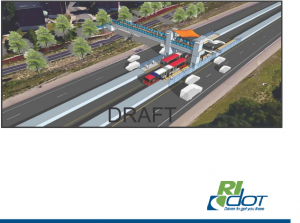
The RIDOT plan to maintain a highway in Olneyville repeats a mistake made by city planners sixty years ago, but it also makes BRT more expensive than it has to be. In order to get to the BRT, riders would have to cross along pedestrian skyway bridges. More bridges means more expense. Those bridges would need to be ADA compliant, which means elevators or ramps. More expense. Adding insult to injury is the fact that these expenses would make the service less comfortable for riders, not more. No one wants to hang out on a skyway bridge above a highway at night. What people want is to be in a populated, safe, attractive area.
So a few things go into bus lanes. We do have a corridor that has demand: Downcity, Smith Hill, Federal Hill, Valley, Olneyville, Manton, the West End, the South Side, and Providence-adjacent neighborhoods of Cranston are highly transit-ready and direct (unlike the 54 route). The best way to provide bus service is to enshrine ideals of competition, and allow the bus to show its strengths. But we should also keep to the thriftiest design, and that means a boulevard.

I hope this explains why bus lanes should remain a part of a 6/10 vision.
~~~~
James Kennedy is a member of the group Moving Together Providence, and advocates for the least expensive 6/10 Connector rebuild, a boulevard. You can follow him on Twitter at @transportpvd.
]]>Deprecated: Function get_magic_quotes_gpc() is deprecated in /hermes/bosnacweb08/bosnacweb08bf/b1577/ipg.rifuturecom/RIFutureNew/wp-includes/formatting.php on line 4387
 I would hate that you should have an unfortunate accident. . .
I would hate that you should have an unfortunate accident. . .
Last night while I was speaking to some people about the Moving Together PVD boulevard proposal, a man in a grey sweatshirt came over and said “This one here better not get into an accident on his bicycle or he might not get to the hospital in time on his boulevard.*” That man, it turned out, was Mayor Joe Polisena of Johnston, Rhode Island.
I took a deep breath, not knowing the man was the mayor of Johnston, and reached out to shake his hand. “Hi, I’m James Kennedy. I understand that this might not make sense at first, but the proposal I’m pushing is about making commutes better for the suburbs. I’d like to explain that to you.”
“I’m the mayor, I don’t need your explanation. How much more is your boulevard going to cost?”
“It’s cheaper, actually. It’ll shorten bridges and allow us to put the grid of the city back together. It’s going to be better for drivers and help us lower costs.”
He walked away.
After Director Peter Alviti of RIDOT made his presentation, Mayor Polisena was given time to give comments. He again turned to me and stated that one thing he knows as a nurse is that “minutes count” and that a boulevard would back up traffic and cause people to die before going to the hospital.
In the second context, his statement was less of a veiled threat, and more of a factually inaccurate statement. But nonetheless, it was irking to have public officials point to me, make reference to me “having an accident” and then not being allowed to respond to explain my proposal. Alviti did not let me comment in public on the proposal, but instead funneled comments through table “stations” which divided the group and made it easier for DOT to control the conversation (I did convince some suburbanites, though. . . ).
Popsicles in Olneyville
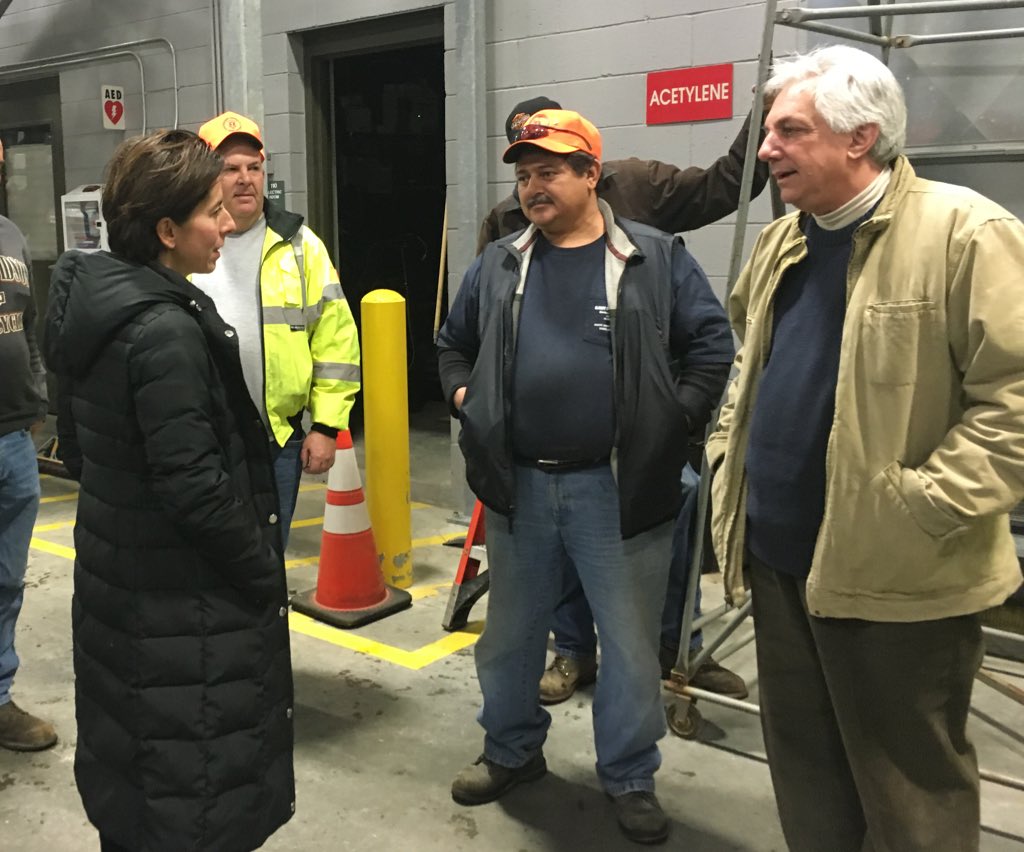 Mayor Polisena may not know how to comport himself in public, but on the contrary, Dir. Alviti does. I know from having met with Dir. Alviti that he is a good man that wants the best for the community, but I think somewhere in the public process Alviti has decided that suburbanites can’t wrap their heads around the boulevard. This is why he’s been pushing a decked highway– what I’ve dubbed the “6/10 Dig”– instead of a boulevard.
Mayor Polisena may not know how to comport himself in public, but on the contrary, Dir. Alviti does. I know from having met with Dir. Alviti that he is a good man that wants the best for the community, but I think somewhere in the public process Alviti has decided that suburbanites can’t wrap their heads around the boulevard. This is why he’s been pushing a decked highway– what I’ve dubbed the “6/10 Dig”– instead of a boulevard.
Alviti grew up in Silver Lake, and he’s told me in closed meetings that he used to walk as a child from Silver Lake to then-contiguous Olneyville to buy popsicles at the store. No child could do that today, and I know for certain that in a difficult political environment, Alviti is putting forward his expensive highway decking approach because he wants to try his best to pull a good situation from a bad plan. But his plan is wrong, and we have tradition on our side on this.
I’ll betchya a Guinness. . .
What is a decked highway? Well, while the Moving Together Providence plan calls for shortening bridges so that they only have to cross the train tracks, a decked highway calls for full length bridges over the train tracks and the highway. But that’s the bridges. The decked highway is itself another bridge: a kind of “world’s widest” bridge. It’s not only full length, but the width of the entire area of whatever part of the highway is supposed to be covered.
How can I tie these disparate threads of the story together? Who do we know who made veiled threats, who was beloved by suburbanites who once lived in the city, and who dealt with heady questions about a world’s widest bridge?

Ah, I knew there was someone. . .
I may not have had the level of enthusiasm for Buddy Cianci that some have had, but I can say one thing: Buddy Cianci knew how to get rid of unnecessary infrastructure.
The “World’s Widest Bridge” (in the Guinness Book!) was once over the Providence River. The purpose of that bridge was to carry traffic around Suicide Circle. Buddy Cianci moved a river and the Northeast Corridor, and took that bridge down, to transform the waterfront of Providence. By contrast, we need not move any river, or any train tracks, and need only remove bridges that are about to fall anyway. And then we propose replacing them with a boulevard that continues off of Memorial Boulevard.
Like Buddy did. You know, but cheaper.
Where there’s smoke, there’s logical fallacies.
And for the record, though the concern raised by Mayor Polisena about traffic and ambulance response times is a legitimate one, he is unfortunately mistaken about the nature of traffic. To begin with, the highway creates a wall with pinchpoints that only allows traffic through at odd intervals, so that even though Olneyville Square has a nearly 50 percent car-free rate and no job centers to draw outside commuters, it has some of the worst traffic in the city. Creating a boulevard would open up and make better use of Harris Avenue (which is currently pinched into a one-way street at one end, and thus carries less traffic than it might otherwise be able to). Building a boulevard would mean shortening bridges over existing crossings like Dean, Atwells, Broadway, and Westminster, and thus allowing totally new streets to be reconnected– essentially adding lanes for traffic to use. Building a boulevard would mean that there would be development and walkability near the Bus Rapid Transit lines, which is essential if we want them to be more than a decoration, and to actually carry ridership. And all of those factors mean that a boulevard would improve traffic, not make it worse.
As a matter of fact, I’ve been taunted about fire and ambulance safety before, and so I researched it by contacting UK-born Dutch biking expert David Hembrow. He pointed out to me that traffic is so efficiently dealt with in the Netherlands that cities and towns have far fewer fire stations than in the U.S., and have better response times. But that wasn’t always the case. Here are some images I pinched from his website:




Oops, that one’s a before from somewhere else. Let me try again. . .
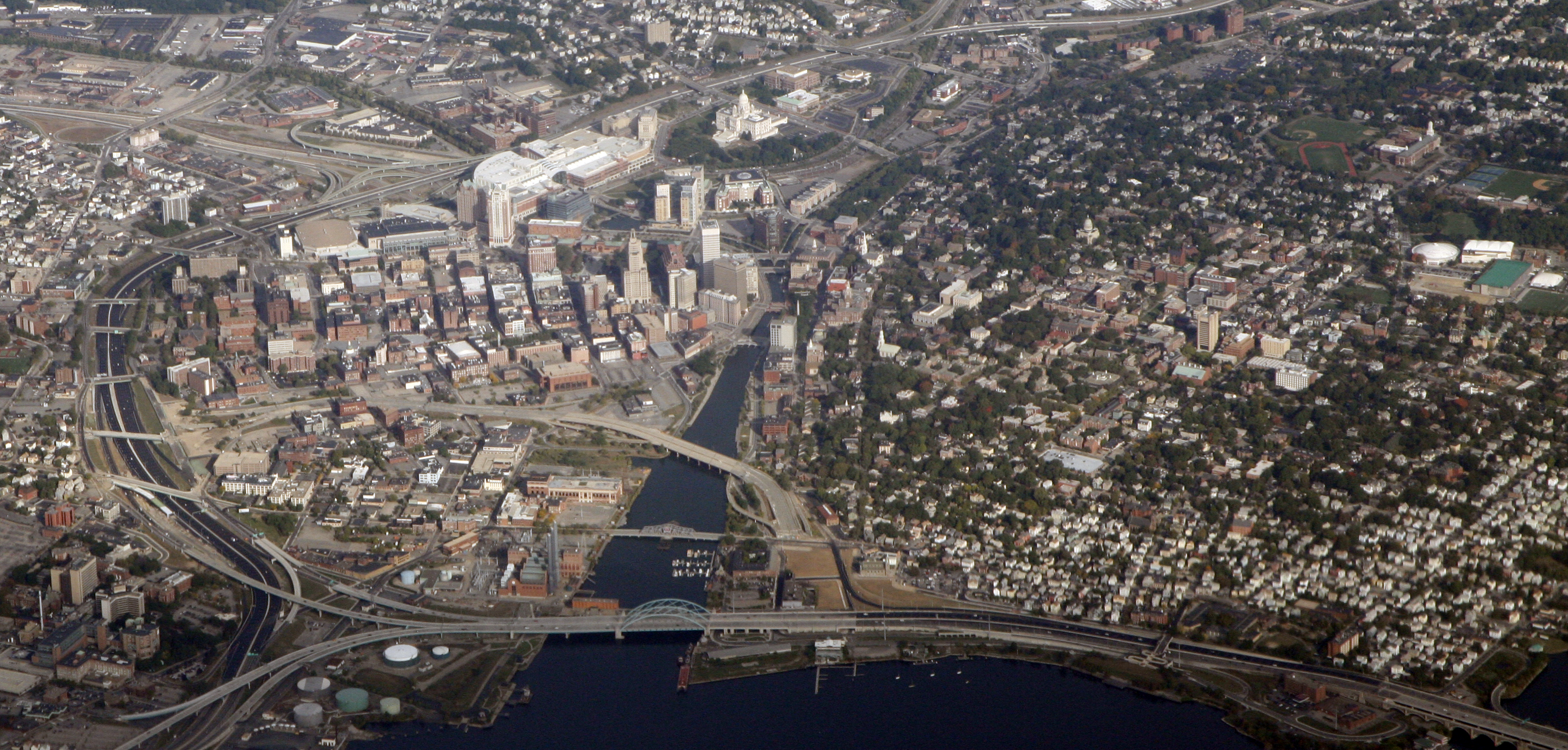
Wait a minute! Malfunction!
.jpg)
Ack! Where are my Dutch photo examples! Okay, last try. . .
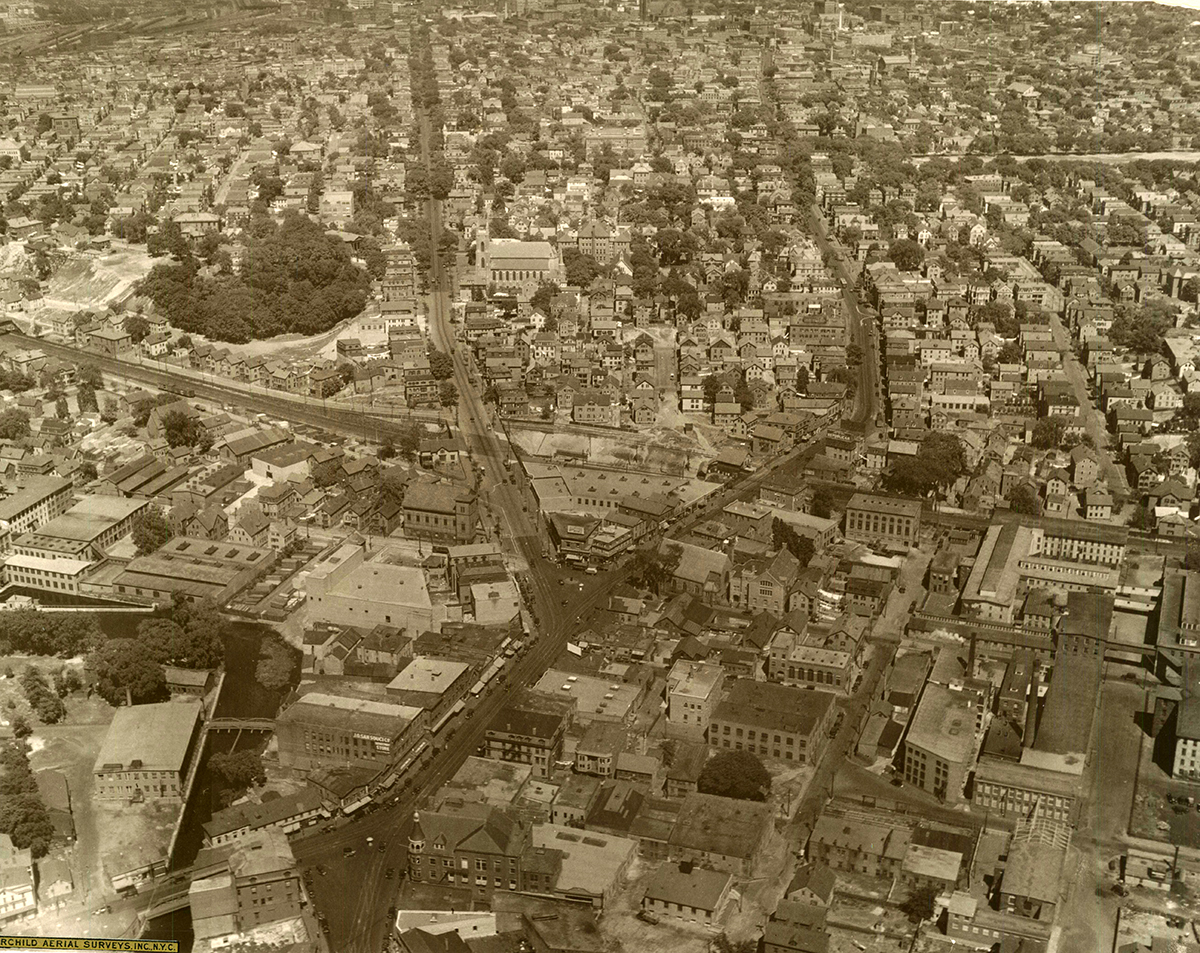
This one’s Olneyvillestadt. I think that’s a part of the Netherlands. . . Next to SilverLakestadt and WestEnderstam. . .
Alright, you get my point. No World’s Widest Bridges, okay? It’s a bad idea. It’s not worth the G-Note getting passed down the hallway (and I ain’t heard about that, you hear? Have some sauce). A boulevard is the best option for suburbanites. All that Dir. Alviti needs to do is refer to the state’s greatest salesman, who, er, well, wasn’t the most legitimate or upstanding politician, but who was someone who knew how to make the Woonasquatucket a place to visit.**
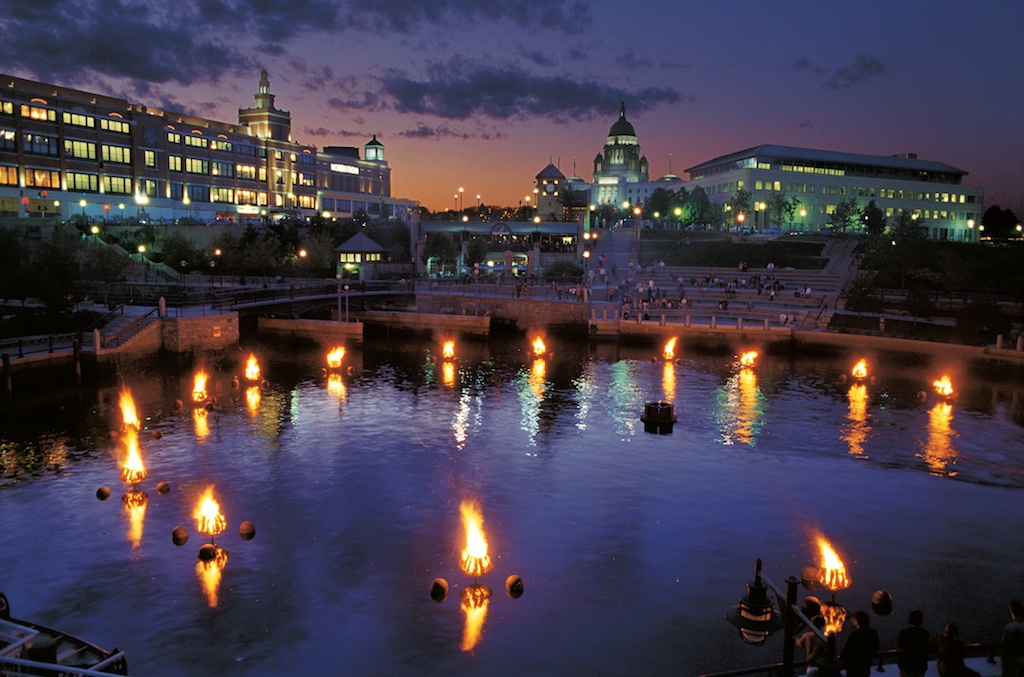
~~~~
*As a side note, I took two buses from work to meet a carpool to Johnston, so I didn’t bike to the meeting.
**I voted for Elorza, alright?
]]>Deprecated: Function get_magic_quotes_gpc() is deprecated in /hermes/bosnacweb08/bosnacweb08bf/b1577/ipg.rifuturecom/RIFutureNew/wp-includes/formatting.php on line 4387
Deprecated: Function get_magic_quotes_gpc() is deprecated in /hermes/bosnacweb08/bosnacweb08bf/b1577/ipg.rifuturecom/RIFutureNew/wp-includes/formatting.php on line 4387
Deprecated: Function get_magic_quotes_gpc() is deprecated in /hermes/bosnacweb08/bosnacweb08bf/b1577/ipg.rifuturecom/RIFutureNew/wp-includes/formatting.php on line 4387
Last Wednesday, RIDOT presented what it is calling a “boulevard-highway hybrid” model of the 6/10 Connector. I’ve dubbed their proposal “6/10 Dig” because it replicates the mistakes of the “Big Dig” in Boston. Our proposal at Moving Together Providence continues to be a true 6/10 Boulevard. Kevin Proft at Eco RI News has done the best comprehensive coverage of this topic of anyone in the media so far, and even I can’t try to reconvene all the information he put together, so please check out his piece.
There are many people who would benefit from the 6/10 Boulevard, but why should drivers support it over the 6/10 Dig option?
RIDOT is wrong. . . It’ll take too long. . .
Cost
A boulevard is a hybrid by nature. The nonsense “highway-boulevard hybrid” name really just means a capped highway, like the Big Dig. The Big Dig was the most expensive highway project in U.S. history. While the Big Dig produced a really nice park for downtown Boston, it left the problems of the highway untouched elsewhere. The same will be true for a 6/10 Dig.
Why is a boulevard cheaper? The 6/10 Connector highway is full of bridges that need to be fixed, and those bridges span parts of the highway itself, as well as over the highway. If we built a boulevard, we could build bridges only over the Northeast Corridor tracks, and that would make the bridges 80% shorter.
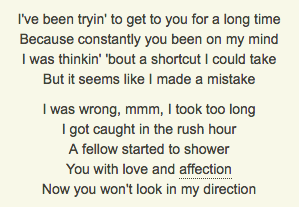
The capping process for RIDOT’s 6/10 Dig also essentially requires digging and covering two tunnels, in a river valley floodplain. This inherently adds all sorts of unforeseen and difficult-to-predict costs that are not part of a boulevard project. The Alaskan Viaduct, which Washington State’s DOT forced down the throat of Seattle after ignoring two referenda that rejected it, is currently an example of how this can go horribly wrong. Big Bertha, the tunneling device that was specially made to dig the Alaskan Viaduct, has gotten stuck several times. There is also ominous settling of buildings in Seattle’s downtown, suggesting that the tunnel may be undermining the foundations of the buildings. These cost overruns in Seattle are a warning against this approach, just like the numerous cost overruns in Boston were.
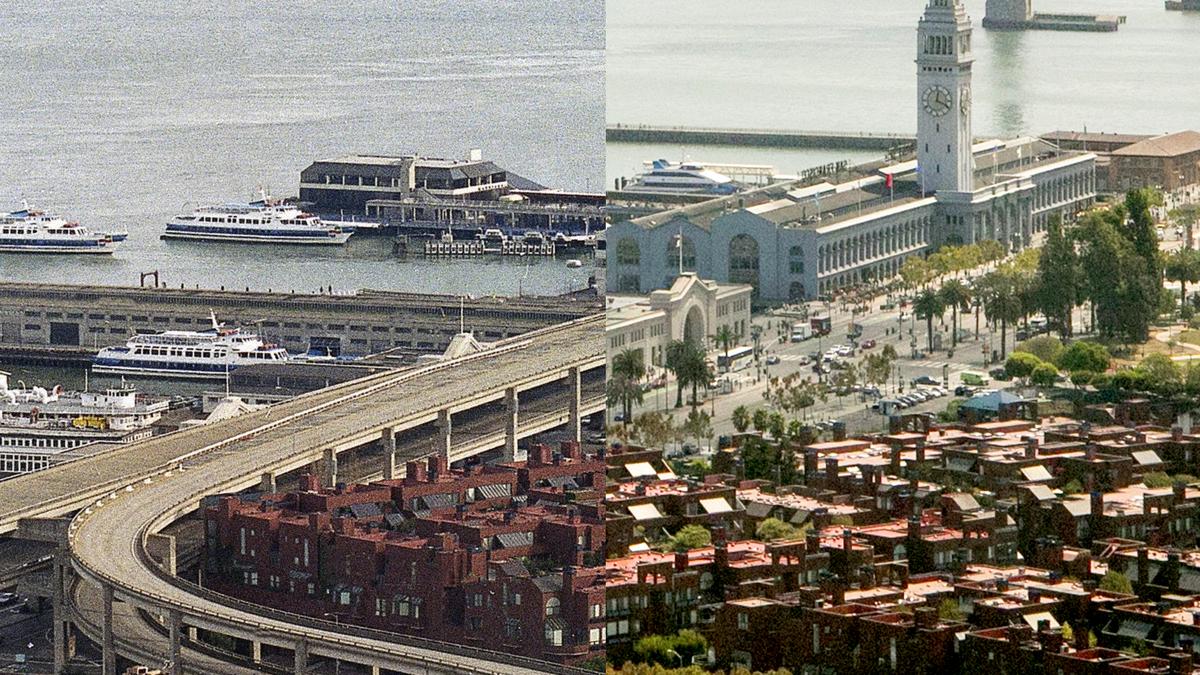
The 6/10 Dig also keeps a highway form to the road, which means it needs exit and entrance ramps. That not only means spending money to build and maintain those ramps, but it means negatively affecting the development pattern for 70 acres of land that would be available in a boulevard model for development.
RIDOT’s 6/10 Dig proposal: spend more to do an uglier job that will leave less potential to earn taxable income in the future.
Moving Together’s proposal: save now, do a nicer job, and add potential development. We also support reducing the toll amounts to reflect whatever surpluses become available from our model.
Congestion
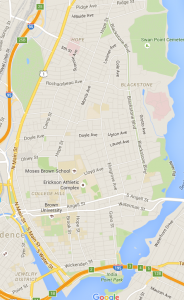 A few people have started to send me angry tweets or emails about how I’m attempting to drive them out of their car. And while I would very much welcome people choosing to drive less, as evidenced by lots of my writing, I’d like to remind people that you can drive on a boulevard. In fact, boulevards originally were a widening of streets that had been much narrower. The Champs Elysée was thought up by Emperor Napoleon III to prevent further revolutions in France’s capital. Today it carries 60,000 cars and 500,000 pedestrians a day.
A few people have started to send me angry tweets or emails about how I’m attempting to drive them out of their car. And while I would very much welcome people choosing to drive less, as evidenced by lots of my writing, I’d like to remind people that you can drive on a boulevard. In fact, boulevards originally were a widening of streets that had been much narrower. The Champs Elysée was thought up by Emperor Napoleon III to prevent further revolutions in France’s capital. Today it carries 60,000 cars and 500,000 pedestrians a day.
Why does a highway work less well for cars than a boulevard? First off, we’re talking about urban highways. A rural highway is a totally appropriate piece of infrastructure that carries cars quickly. An urban highway fails because it blocks many of the advantages that cities have to deal with traffic.
The East Side is a part of Providence that has been (relatively) less affected by highways than other parts of the city. It does have I-195 cutting across its waterfront, which carries its own issues, but unlike Downtown Providence or the West Side, Olneyville, and Silver Lake, it has no highways cutting it directly off from other parts of itself.
Wouldn’t an Angell Street Expressway improve traffic congestion? After all, the East Side has some of the largest employment centers in the state, and because many of the jobs it serves are high-income, a sizable portion of its workforce chooses to live outside the city and commute by car. A hypothetical Angell Street Expressway helps to explain what’s going on in Olneyville with traffic.
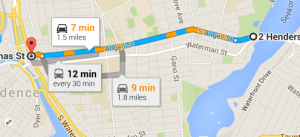
If you look at a map of the East Side, you’ll see that north-south there are fifteen pairs of streets between Butler and Main Street, inclusive. That’s fifteen streets, each with two lanes.
Google says it would take 7 minutes to go up Angell Street at the current speed limit. Having an expressway might half that time, in theory.
But what of those north-south trips? In order to make the highway work at high speed, it would have to be limited-access, meaning that it would have only a few entrances and exits. All of the traffic that currently flows through 30 lanes of small streets would have to cross the highway at odd intervals– perhaps at Main St., Hope St., and Gano St.
This would be a disaster, but that wouldn’t be the only thing about the Angell Street Expressway that would be messed up for drivers.
A hypothetical Angell Street Expressway would need exit- and entrance-ramps for those three stops. I took a screenshot of an area of the map roughly the size of the Viaduct and placed it over Thayer Street. There’d be a second one like this on the other side. Several blocks of housing and businesses would have to be removed in between the exit- and entrance-ramps, for the full length of the highway. And two more sets of exit- and entrance-ramps would be needed at Main and Gano, respectively.
Would this have a further effect on driving times? Of course. Currently, many people walk on the East Side, and that contributes to the fact that Thayer Street is lively even sometimes during blizzards, and can have tremendous success drawing people for business when the street is closed to cars. Suddenly every trip would need to be driven. And the lack of a grid would mean that people who were driving short trips would take the highway to get around and through this maze.
The East Side is not perfectly uncongested, especially on Thayer Street itself, which is very popular, and narrow. But doesn’t it seem odd that a part of the city where the most employment and economic activity is happening manages without an Angell Street Expressway, but Olneyville– a part of the city that is depressed, and has a nearly 50% non-car-ownership rate, but no major industries– has constant traffic? Olneyville Square at 3:30 on a Wednesday looks like Thames Street on 4th of July in Newport, but with none of the apparent economic activity driving that congestion.
A capped highway could connect some streets, because the connective parkland built over the highway might be wide enough to slightly expand the range of choices to drivers. But it would do so at great cost now, and into the future, and so the number of bridges that could be built would be limited. A boulevard, because of its low cost, could reconnect almost all the streets on either side, and at much less cost. And what that means is that instead of having to sit through Olneyville Square to get to a highway that will be almost as backed up, you can glide along a number of streets in a connected neighborhood.
A Tested Idea

We’ve already been here, and it wasn’t any flower-sniffing hippie that brought us there. The late Buddy Cianci moved train tracks and a river to put together Memorial Blvd and Waterplace Park, both of which have been successful by any measure. But because of the weird engineering choices that had to go into those projects, they were obviously very expensive. By contrast, the 6/10 Boulevard project does something we’ll have to do one way or another: tear down the old 6/10 Connector. The only thing that is different is it calls for not rebuilding the monstrosity. By saving money, we can lower tolls. We can add development land to the tax revenue of the state and city. But we can also better support drivers by removing the old grey wall that currently stands in their way.
~~~~
UPDATE: Addressing some other concerns.
The Great Northwest Passage
Lewis & Clark, here I come.
Boulevard proponents do not intend to remove the whole of Rt. 6. This is something that keeps coming up as a concern, and that is something I want to address here.
It’s It’s It’s understandable for people not to know this, since everyone in the state shouldn’t be expected to live and breathe the 6/10 Connector as I do, but the Moving Together Providence proposal does not make any changes to the northwest corridor of Rt. 6. Our proposal calls for the boulevard to transition back to a highway somewhere around Hartford Avenue north. Where the map cuts off to the northwest is roughly where such a transition to a highway could go. It’s not nearly as harmful to have Rt. 6 along the edge of Manton into Johnston as it is to have it cut through other parts of the city as the 6/10 Connector, because there are not meaningful historic commerce or community connections being blocked. The Woonasquatucket Greenway already exists parallel to this section of highway.

Justin Katz of Ocean State Current-Anchor happily surprised me when he endorsed the idea that the people of Providence should have the greatest say in the form of the 6/10 Connector, and that spurred a conversation in the comments section of his post. Commenters ShannonEntropy and Tom Hoffman brought up issues related to the interests of suburban commuters, citing the lack of a good “east-west” route (ShannonEntropy’s words). Hoffman, who has written in support of the boulevard as part of the labor-oriented Common Ground RI, did not mention an east-west connection in his comments on the piece, but has brought this issue to me in other conversations.
The search for the Great Northwest Passage led Lewis & Clark astray, and I think this concern is also wrongheaded here. Just to illustrate the point, let’s look at a density map of Rhode Island.
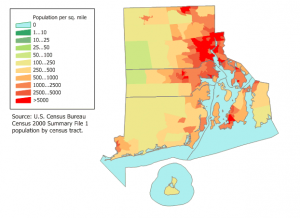
Yes, it’s clear that commuters from the northwest of the state use Rt. 6 if they want to come into the city– and they should continue to. No one– let me repeat that– no one is trying to get you to stop driving to Providence from Johnston or points northwest.
The issues that plague the 6/10 Connector don’t emanate from Johnston commuters. They emanate from the huge number of local trips that are misplaced onto the Connector by a lack of a street grid. All of the commuters from the northwest of the state could try getting on the highway at once, and my feeling is that even together, they’d have a hard time creating a traffic jam, but if even a small number of Providence residents are pushed onto the highway for the short trips they’re taking between neighborhoods, it would create a traffic jam. That’s what happens everyday.
There’s an enduring dream of a Great Northwest Passage out of Providence and across the state, and some wish that that passage would have also connected with I-84. I think that would be a mistake as well. The natural, self-organizing nature of commuter and residency habits has created no problem here. The 6/10 Connector has. If we’d knocked through the rural hinterlands of the state with an expensive highway addition, we would be causing Big Government to redefine and socially engineer that reality away from what it is.
How to transition?
How is this done? One of the cheapest, more congestion-fighting, and safest ways to transition a high-speed road to a lower-speed one is a roundabout or traffic circle.
Traffic circles have downsides, particularly for cyclists, which is why in the Netherlands, cyclepaths are usually routed around them. But for transitioning the edge of a city into a highway, roundabouts create a highly efficient compromise between pedestrian and car needs, which also costs a lot less than signaling. State DOTs like Wisconsin’s require roundabouts as the first consideration for all newly designed intersections, in part because they save money, and in part because they reduce the incidence and severity of crashes.
The example I use above is somewhat different than what I have in mind, but still illustrates the self-organizing nature of traffic in a traffic circle. The actual implementation of the idea as a transition point between highway and boulevard would differ because it would not be in the center of town, but rather on the edge of urban development towards something else. Philadelphia’s Eakin’s Oval– a transition between the very fast Kelly Drive/East River Drive and the boulevard-like Benjamin Franklin Parkway– and Logan Circle– the second transition, between the faster part of the Parkway and the much slower, more urban part near Philadelphia’s City Hall.
If you think, “Gee, the Ben Franklin Parkway doesn’t look that urbanist to me” you’re right. Jane Jacob’s hated the Ben Franklin Parkway, which she identified in The Death and Life of Great American Cities as a big-planner departure from the more organic street form of Philadelphia around places like Rittenhouse Square. But that’s the point, in a way: a boulevard is not perfect urbanism. It’s a compromise point between the needs of drivers to drive in the city, and the needs of the city to be a city. The Ben Franklin Parkway isn’t my favorite part of Philadelphia as a native of that region, but it is a beautiful and enjoyable one, and economically productive. It features widely on postcards of Philadelphia, as the endpoint of the famous “Rocky Steps” of the Museum of Art.
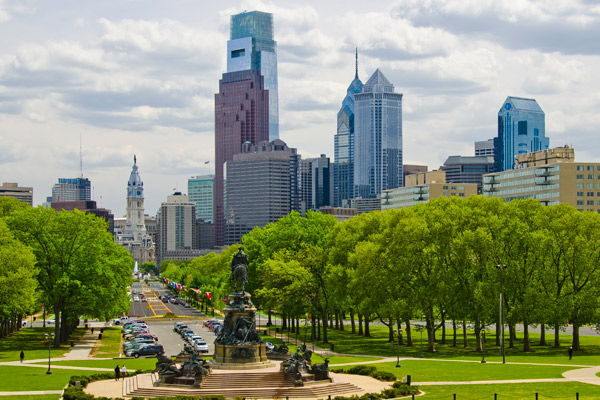
A failed vision
We should not use the most expensive item in our pantry for every purpose, but that does not make that item bad. The distortion of the American diet, many have pointed out, comes not from the “bad” foods we eat being “bad for us” so much as from the weirdly top-down planning that makes those foods everyday fare. This same paradigm affects driving, and transit.
Just to show you that I’m not biased against driving, let me give you a transit waste example.

The transit planner Jarrett Walker, out of Portland Oregon, produced a stunning redesign of Houston’s bus system. The Houston system had been bleeding ridership for many years, and Walker redesigned the system to be more comprehensive, more frequent, and more convenient, while not spending any extra money on it. Naturally this involved some tradeoffs, but the vast majority of previous riders of Houston’s buses continue to use the same bus stop now that the system has changed. Ridership is now increasing, instead of decreasing.
Walker has described how members of the public whose bus stop did change sometimes did not like the fact that they had to walk an extra quarter mile to get to the route, not understanding that buses don’t simply represent lines on a map, but also lines that have other dimensions– like frequency and span. If you have two buses to choose from, but they’re half as frequent, and their resultant low ridership means they stop at 7 PM instead of 12 PM, then the two buses are a less useful service than just one.
A bus is a cost-effective service if used right, but it’s also an expensive service that requires on-going maintenance and labor costs. Using the most expensive item in your toolbox– a bus– to meet the needs of a pedestrian trip does not make sense, especially if spreading those resources undermines both.
People often say I’m “the bike guy” because they misunderstand my point about bike routes. Bike routes an inexpensive tool, so the more we can meet the needs of commuters on bikes, and then use our more expensive tools like roads and buses sparingly, the better we’re able to marshall our resources to the best result for taxpayers and commuters.
If you want to meet the needs of disabled people, for instance, you could spread your bus resources really thin, and provide a bad bus service for everyone, or you could create a few very good buses for the same cost, but use the savings to fill the gaps with good pedestrian and bicycle infrastructure.
The failed vision of RIPTA is often to stop in each nook and cranny, to turn into each parking lot, to hit each 100 foot gap, and by doing so make the route take forever and work for no one but the most desperate. A better vision would have RIPTA marshall its resources towards the highest uses, and let bicycles and sidewalks fill in the gaps.
How that failed vision applies to roads
Urban highways were a utopian vision by planners like Le Corbusier. Here was Le Corbusier’s vision for Paris:
Y
You can see not only that this is an awful vision, but that it resembles the 1960s Big Government views of people like Robert Moses. What Le Corbusier misunderstood was that the apparent efficiency of highways doesn’t work in the context he imagined it. He forgot parking, he forgot traffic congestion, and most of all he forgot that highways are the dollop of expensive whipped cream on the pancake, not the pancake itself.
The RIDOT 6/10 Dig proposal reminds of this 1920s era, when planners thought they could direct each activity from above with unlimited resources. It’s an entrancing vision, actually, and if you forget how much it would cost, or how many resources it would swallow, you can almost see why it seemed like a great idea.
In a bus, the bus is the expensive option, and walking or biking is the final connection. They exist together. With a highway, the highway is the expensive option, and driving a city street is the final connection. To imagine that all the city streets would disappear into huge Jetsons-like highways, with towers-in-the-park between them, is wrong.
Why a boulevard?
A boulevard makes the most sense because it rejects the utopianism of Le Corbusier, and instead uses highways as the tool they’re meant for– long-distance travel between two productive places. The boulevard reconnects streets. Yes, there are commuters from the northwest, and because they come from suburban and rural areas, it is very likely that many of them if not all of them will continue to drive post-boulevard. But because their numbers are less great than our intuition says, that’s actually not a problem. The goal of a boulevard, or of any urbanist project, is not to force people not to drive, but to create the right set of options so that driving doesn’t become the only way around. Let’s take our heads out of the 1920s’ futurism, and build the 6/10 of today.
~~~~
]]>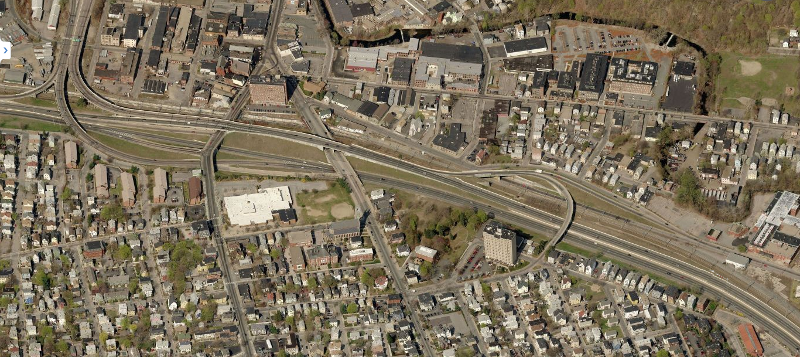
With Governor Raimondo’s recent push for transportation funding, people are talking about patching up the 6/10 Connector vs. replacing it with a boulevard. Best practice in urban design recommends replacing urban highways with boulevards. But that would be something we haven’t done before in Rhode Island, so it’s understandable that some people have concerns. Here are a few questions I thought you might have about updating the 6/10 Connector for the 21st century.
- That’s a big change. Wouldn’t it be expensive to remove the highway?Governor Raimondo is proposing a tractor-trailer toll that would allow the state to bond for $700 million. $400 million of that (plus another $400 million RIDOT wants to get from the Feds) is earmarked for the 6/10 Connector repairs. That is expensive.
Prices vary a lot for building highways, but urban highways with as many overpasses as the 6/10 Connector tend to be on the high end of the scale (and $800 million is quite high). Boulevards (think Memorial Boulevard in Providence, but more multimodal) tend to have a cost roughly ten times lower than an urban highway. Imagine how many structurally-deficient bridges we could make safe with an extra $360-720 million? That’s a very rough cost comparison, but what we can be sure of is that replacing the 6/10 Connector with a boulevard (even tripped out with the best complete streets features you can think of) would cost dramatically less than rebuilding it as a highway.
- So many cars use the connector! Wouldn’t removing it create massive traffic jams?Actually many cities have removed excessive urban highways and seen no marked increase in traffic. There are a couple reasons for this. Traffic is created through a process called “induced demand” where if you build more highways, drivers will use them. Conversely, if you eliminate an urban highway, fewer people will use it as a short-cut.
“But wait!” you say. “I use 6/10 as a shortcut! You want to reduce my transportation options!” Actually, in other cities that remove urban highways, they see the traffic that previously used the highway spread out over the city’s other streets. And there’s less potential for traffic jams when drivers have lots of options. It’s like how bugs congregate around lights on hot summer nights, but out in the dark it’s less buggy. 6/10 is the bug-clogged light, city streets are the cool night air.
And one more thing: our current transportation network overwhelmingly favors driving; it has big highways that cut swaths through neighborhoods that are uninviting to other ways of getting around. Leveling the playing field by making our street system more comfortable for more ways of getting around (RIPTA, walking, and biking as well as driving) gives you more choices and more freedom. Plus, it means more other people are choosing to walk or bike and they’re not clogging up the road in front of you.
- It’ll never happen. We can’t do innovative things in Rhode Island.I mean, this isn’t that innovative. And hey, we started the Industrial Revolution and moved rivers to revitalize downtown Providence. I think we have it in us to make a prudent economic decision to give Rhode Islanders more transportation options and safer bridges.
Plus, you cynics, politicians like ribbon-cuttings and ground-breakings. It’s not as sexy to photo-shoot the replacement of an archaic 1950s-era project as it is to pose for the first complete multi-modal corridor in the State.
We can assume that because the 6/10 Connector is in Raimondo’s investment plan, now is the time that something will happen with it. The state should choose the approach that is best for the neighborhoods adjacent to the corridor, which coincidentally is the option with the best return on investment. Replace the 6/10 Connector with an urban boulevard.
Want to help make this happen? Transport Providence is organizing a walk around the area in question today at 5:15 with Providence City Councilman Bryan Principe. The best thing you can do is to talk to people about this. Which people? Especially your representatives (state, federal, and city if you live in Providence), the Governor’s office, and RIDOT.
]]>The oldest section of the 6/10 Connector, Rt. 10 Huntington Expressway, is the oldest highway in the state, and is mostly redundantly a mirror of I-95. It cuts neighborhoods from each other, lowers property values, takes up developable space, and pukes smog into the air for poor folks to breath. One of our state’s best resources, the Washington Secondary Bike Path, is poorly used because its natural connection to Providence from Cranston is at Cranston Street, where only the boldest ride their bikes under the highway through thick, multi-lane traffic jams.
Read: Why Should We Remove Rt. 6/10?
Read: RIDOT Director Alviti Promises 6/10 Bus Lanes: Why Are They a Bad Idea?
Read: Providence is in the Top Ten for Lane-Miles Per Capita of Highway
But forget all that. Here are some places that used to be highways in other parts of the world. If pictures can’t convince you, then what can?
Seoul, South Korea
Used to be a(n American-built) highway. This is one of several that have been removed.

Portland, Oregon
Used to be a highway. The on- and off-ramps for the Harbor Drive highway now serve a bike path.
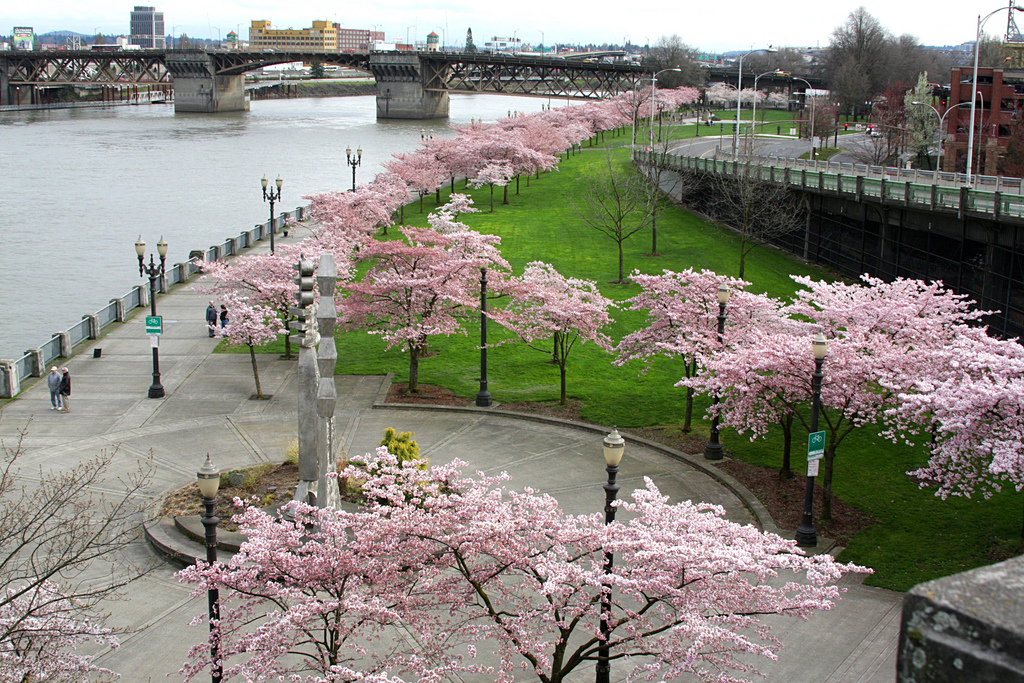
San Francisco
Used to be a highway. There was no access to this old ferry building when the Embarcadero stood. Luckily an earthquake took it down, and the people of San Francisco decided it wasn’t worth replacing it.

Milwaukee
The Park East Freeway–not there anymore. Removed.
Chattanooga, Tennessee
Used to be this: limited access.

Now it’s this: complete streets.

Memphis
Before.
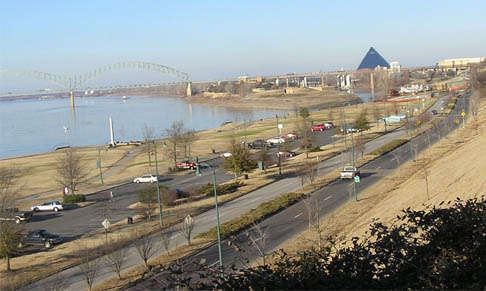
After:
Jamaica Plain, Forest Hills
I-95, proposed:

Almost happened:

Stopped:

Dallas
Rt. 345. What it is:

What it could be: lots of development land, right next to downtown.

New York City
West Side Highway. Before:

After:

Philadelphia:
(Never happened, South Street)
Proposed:

What it would’ve taken:

Isaiah Zagar helped fight that highway. Here’s his Magic Garden.

Providence
How it was: (Oh yeah! We did that!)
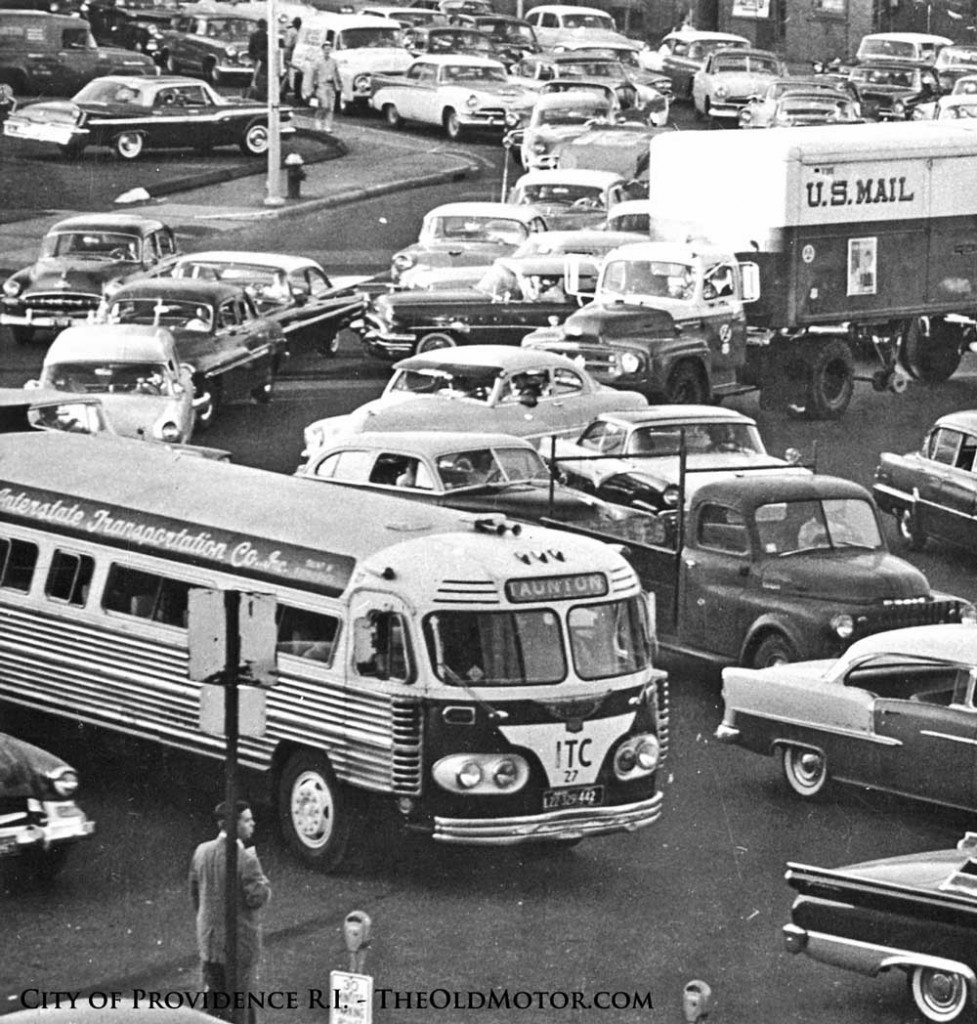
How it is:

Olneyville
How it was:
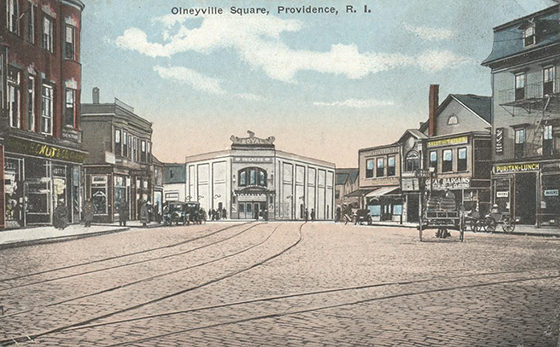
How it is:

Call your reps, state senators, and other officials, and let them know what should be done with the 6/10 Connector. No urban place has ever been made better by a highway. Every urban place that has removed a highway has flourished. It doesn’t make sense to spend so much money on something that will make our city worse. It’s a no-brainer.
~~~~
]]>
